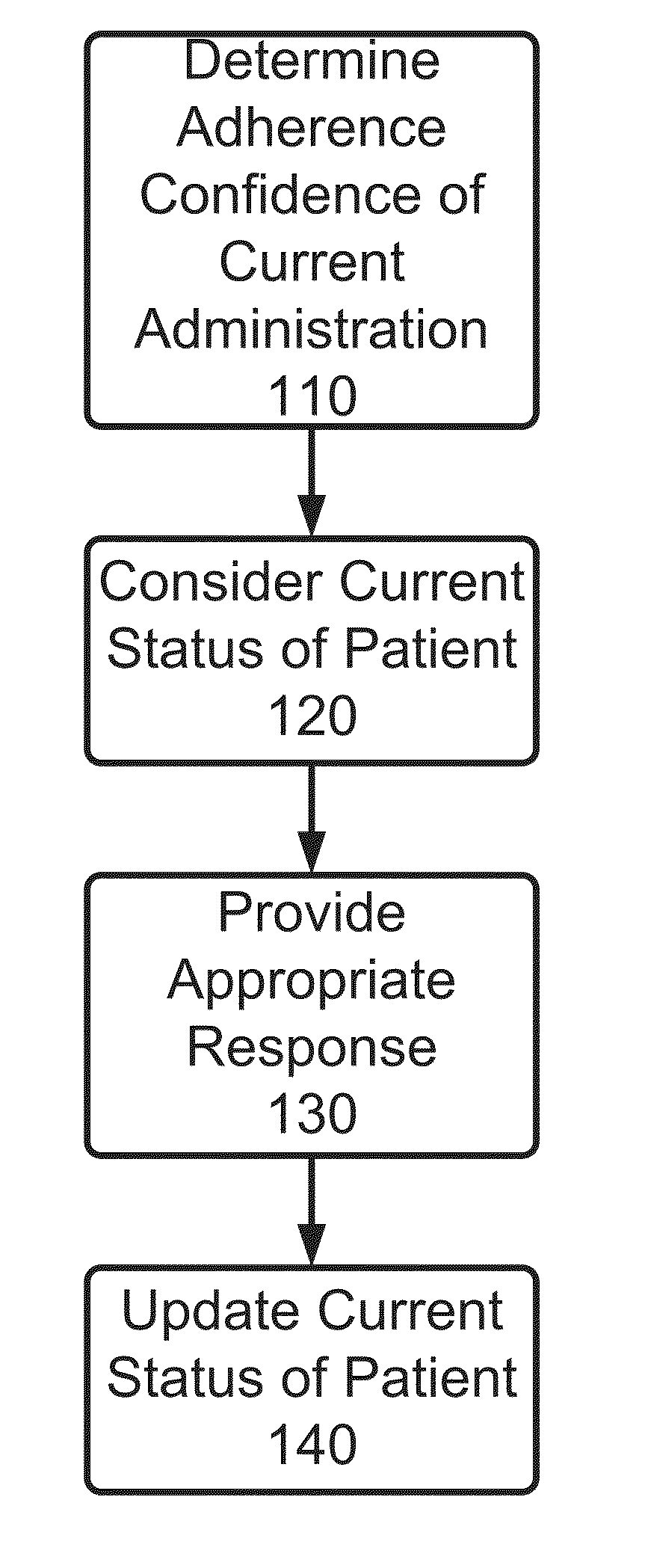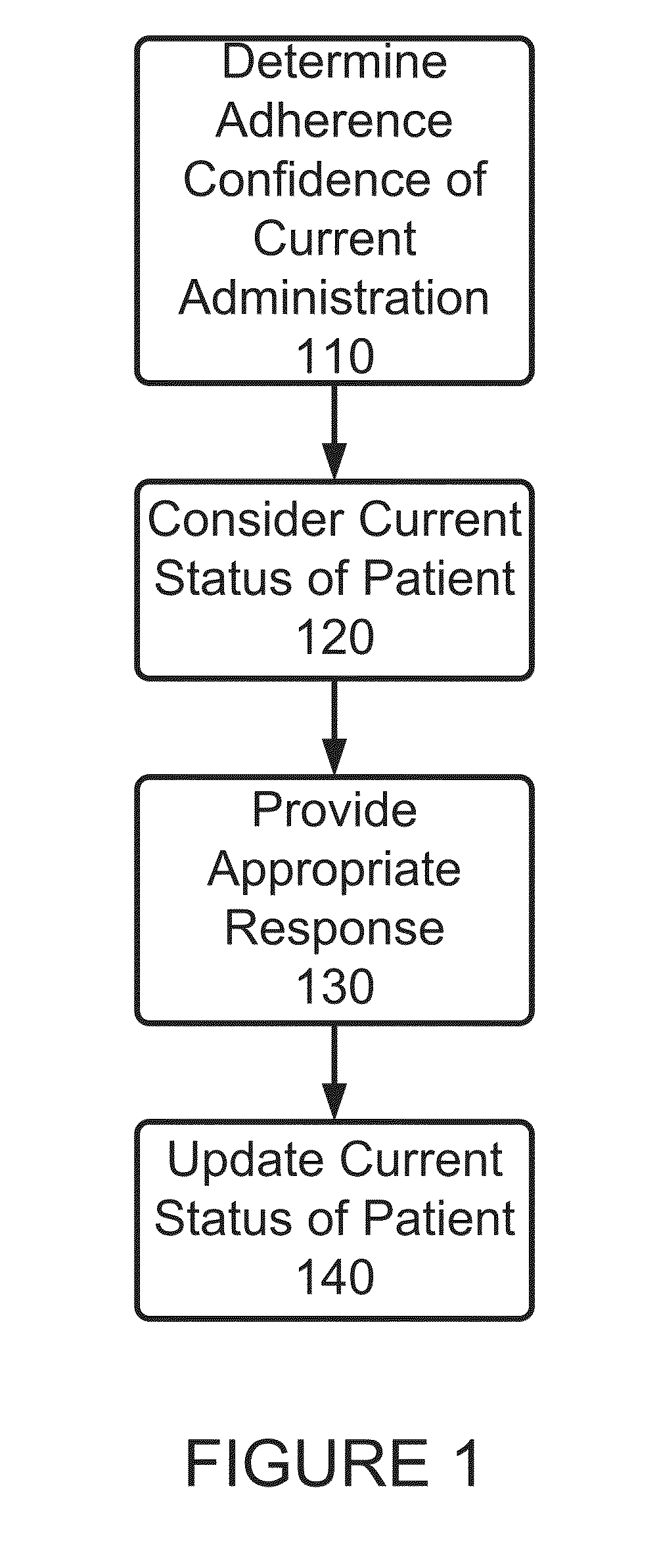[0018]In accordance with various aspects of the present invention, a web-based (or otherwise housed) dashboard may be provided to manage information captured from a computer vision software module that uses webcams to automate the direct observation of medication administration without the need for one on one human supervision. The dashboard will allow healthcare providers to monitor medication adherence rates and interact with patients through a patient issued (or patient owned) webcam enabled laptop, smartphone or other device in the hospital room, at home, or in any other convenient location, and store, monitor and review recorded video data associated with one or more patients using the system. This interactive and functional application is unlike traditional electronic medical records which provide a full medical history but often failing to capture data reflecting crucial health behaviors. The inventive solution offers a clear snapshot of medication adherence behavior both past and present. Healthcare providers may be notified of behavioral trends in medication adherence, receive alerts, and review correlations to medication efficacy and contraindications. Further, healthcare providers may view such information at the patient, small group, or population level, thus allowing for trends to be noticed, yet individual attention to be provided.
[0019]Importantly, a user may be able to quickly switch from viewing one patient's profile in the dashboard to viewing entire patient populations in one screen. Summary statistics and demographic information may also be accessible. The system may highlight predictive patterns of behavior and alert care providers to possible “danger zones”. Other population based metrics may also be employed. The more data collected, the more efficient the system will be at predicting patterns and risk. The integrated communication platform may allow for patient communication and intervention when appropriate. Interventions may include automated messages (text, audio, visual) on the patient's device triggered by specific events or trends, live phone calls, video conferencing requesting in-person appointments, status updates or other appropriate notifications and contacts. This may encourage adherence to prescribed protocol and reduce expensive hospital readmissions.
[0020]Embodiments of the present invention may allow automated direct observation of medication adherence to be used as a population health tool, especially where the risk and cost of patients not taking medication is high and stakeholders have a vested interest in monitoring behavior. The system may help to virtualize the patient, avoid the reliance on self-reporting or direct human supervision, and still allow for intervention when necessary. The system may also work to improve medication adherence. Patient safety and treatment will confidently be assured and fewer supervisory personnel will be needed to supervise much larger patient populations thus reducing overall costs of patient supervision. Summary data of medication adherence rates may provide the basis for intervention and reaction to the medication could lead to a change prescribing practice. This is especially useful for chronic conditions, complex drug regimens, and patients transitioning from an inpatient to an outpatient environment. Faster follow-up in certain at risk populations may reduce rehospitalizations. The system may also have applications in clinical trials, lowering costs and increasing safety and efficacy because of more reliable adherence data. Better regulation can be enforced and action swiftly taken before drugs come to market.
[0022]Therefore, various embodiments of the present invention will provide a state machine of the type described below that utilizes audio / video information to offer a population health tool to manage any number of patients, understand their behavior, and communicate and intervene when necessary or desirable. The system further employs machine learning to identify one or more trends and make automated judgments about patient states, as well as an ability to learn and highlight outliers or at risk populations. Thus, based upon captured information, patients may be placed into states that may aid in predicting those patients at risk for future hospitalizations, for example, or other types of situations where a varied intervention strategy may be beneficial. When considering large patient populations, such automated monitoring and categorization allows for monitoring of such patients, allowing managers to direct their attention to patients who might best benefit from such attention, and allowing the system to provide automated intervention when determined to be appropriate. This level of automated, intelligent intervention allows for effective management of patient behavior and medication adherence. Existing systems fail to capture patient behavior. Various embodiments of the inventive solution, including the described state machine, provide data relevant to medication adherence and other medical treatments as opposed to entire patient history, such as in an existing electronic medical record. Furthermore, the system acts as a video repository, recording administration by patients, and thus allowing for future review of such administration sequences by a manager or other healthcare professional if appropriate. Thus, upon determination by the system in a manner noted above, patients in one or more predetermined states may be indicated for such manual review by the manager or other healthcare provider. Finally, the inventive system may be applicable not only to adherence information, but to any patient action or healthcare related treatment to which monitoring may be applicable.
 Login to View More
Login to View More  Login to View More
Login to View More 


